- Profile
- Images
Surname/tag: Freemasonry
Introduction
The goal of this project is to help identify people who are members of Freemasonry, honor them, and any achievements they may have.
We do this by
- Setting identification criteria
- Providing guidelines on
- Terminology
- Organizations
- Formatting
- Categorization
- Helping with possible research connections
Project Members:
- Bro. Eric Weddington
- Dan Thompson
- Carolyn Martin
- Erin Van Zante
- David Peter
- Taylor Worthington-Gilchrist
- W. Bro. David Thomson, III
- Bro. Tony Pope
Will you join us? Please post a comment here on this page, in G2G using the project tag, or send me a private message. Thanks!
Freemasonry
Freemasonry is a complex topic, and there are many resources online to find out more information. Below are introductory links to various topics. This is not meant to be a complete treatment of the subject.
Wikipedia articles:
- Freemasonry
- Grand Lodge
- Masonic Lodge
- Grand Master
- Prince Hall Freemasonry
- Masonic Appendent Bodies
- Women in Freemasonry - (Because the vast majority of Freemasons are men, masculine pronouns are used below.)
- Order of the Eastern Star
Also see more at the Prince Hall and African Lodge project page for Prince Hall Freemasonry.
Terminology
Freemasonry has a lot of peculiar terminology. This is because of the long history of Freemasonry. The language and terminology goes back to the 18th century, typically from England, Scotland and Ireland. Below is some common usage, and mis-usage:
- A man is a "Freemason". Belonging to "Freemasonry".
- Occasionally, he is called a "Mason", but this is used informally.
- Do NOT use "Free Mason". It is a single word.
- They go to "Lodge", or a "Masonic Lodge", if you have to differentiate between other types of Lodges (in other Fraternal Organizations).
- A man is "made a Mason in a Lodge". This means that he took the three degrees of Freemasonry.
- Initiated, Passed, and Raised
- This is terminology that refers to receiving the three degrees of Freemasonry. The First (Initiated), Second (Passed), and Third (Raised) degrees respectively. There are dates for each one of these. Most of the time, all three happened in the same Lodge. Sometimes, it happened at different Lodges. Occasionally, you might have some or all of this information. If you do, then you may want to record it in a profile Biography in some way like this:
- Initiated: <date>, <lodge>
- Passed: <date>, <lodge>
- Raised: <date>, <lodge>
- This is terminology that refers to receiving the three degrees of Freemasonry. The First (Initiated), Second (Passed), and Third (Raised) degrees respectively. There are dates for each one of these. Most of the time, all three happened in the same Lodge. Sometimes, it happened at different Lodges. Occasionally, you might have some or all of this information. If you do, then you may want to record it in a profile Biography in some way like this:
- See this Wikipedia article on Masonic Lodge Officers
- S&C, Square & Compasses. This is the main symbol of Freemasonry. It is composed of a carpenter's square at the bottom, and a pair of compasses opened up, at the top. In the United States, it is common to see the letter 'G' in the middle. Other countries may not have the letter 'G' in the middle. Older instances of this symbol may not have the letter 'G' either. There are many examples of this symbol throughout this page.
Other Masonic organizations
There are other organizations within the larger context of a "Masonic Family". Many of these organizations were created quite some time ago. Some are still very thriving organizations, others are in a slow decline. These are collectively known as "Appendant Bodies"
See the Wikipedia article on Masonic Bodies for more information.
Identification & Sources
How do you know if a person was a Freemason? Ideally, you should have some sort of source, and refer to that source in a profile. There are good examples of different sources at the Sources overview, and it shows you how to use them in a profile.
The important thing is to focus on continuous improvement of a profile. If you have the information linked to a known source in some manner, that is a step in the right direction.
The sections below go into detail about different ways to identify a Freemason, or Freemasonry sources that you can use on a profile. We will discuss:
- First-hand Knowledge
- Second-hand Knowledge
- Gravestone or Grave Marker
- Masonic Sections of Cemeteries
- Masonic Cemeteries
- Obituaries
- Membership Cards
- Family Bible, or Masonic Bible
- Information from a Lodge or Grand Lodge
- Proceedings of a Grand Lodge
First-hand Knowledge
- Did you personally know that this person was a Freemason? If so, then mark that as the source. For example:
- [[Whitten-1|Whitten, Chris]], personal knowledge, January 1, 2016.
Second-hand Knowledge
- Did another family member know that this person was a Freemason? If so, then mark that as the source. For example:
- Schmoe, Joe. Personal recollection, January 1, 2016, as told to [[Whitten-1|Chris Whitten]] via the phone. Notes in the possession of Chris Whitten.
Gravestone or Grave Marker
- The person may have had the symbol of the Square & Compasses (S&C) on their gravestone or grave marker. In many cases, especially for older profiles, this is the only information we may have to identify them as a Freemason. Find-a-Grave can be a good resource when there are photos of a gravestone.
- Here are some examples of the S&C symbol on gravestones:

|
| Example 1 |

|
| Example 2 |
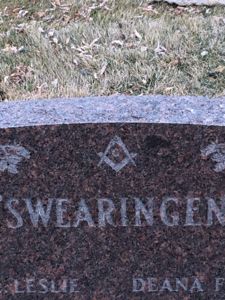
|
| Example 3 |

|
| Example 4 |

|
| Example 5 |

|
| Example 6 |
- Note that Example 6 above is more subtle in its display, in that the symbol of the Compasses is actually part of the top of the gravestone.

|
| Wade H. Smith gravestone detail with symbol of Past Masters Jewel |
- The photo above is an unusual example. The gravestone detail of Wade H. Smith shows the typical symbol used for a Past Master of a Masonic Lodge in the United States: The Compasses on top, an arc of a circle at the bottom, and on the inside is a blazing sun.
- It is common in the United States to see the letter 'G' in the middle of the Square and Compasses. Sometimes, older gravestones can be found without the letter 'G' in the middle, and literally only have the Square and the Compasses. In Europe, it is more common to see the Square & Compasses symbol only, without the letter 'G'.
- Gravestones of Freemasons do not always have the symbol of the Square and Compasses. They might have symbols of some of the "appendant bodies" of Freemasonry.
- (TBD: Example photos of gravestones with Scottish Rite symbol)
- They might have the symbol of the Double-Headed Eagle of the Scottish Rite.
- Gravestones may also have a triangle with the number "33" inside it, or it may be a "blazing triangle", with rays emanating from the triangle. The "33" represents the honorary 33rd degree of the Scottish Rite. If it has "32" inside, then it represents the 32nd degree, the highest degree obtainable in the Scottish Rite.

|
| Scottish Rite 33rd degree blazing triangle emblem |
- The photo above show such a blazing triangle emblem with "33" on the inside. This is on the gravestone of Dr. William A. Campbell Sr. in Evergreen Cemetery in Colorado Springs, Colorado, United States. He was a 33rd degree Scottish Rite Freemason.
- (TBD: Example photos of gravestones with Shriner symbol)
- Another common gravestone symbol is the Shriners emblem.
- It is required that one be a Master Mason before joining these other appendant bodies, such as the Scottish Rite or Shriners.
Masonic Sections of Cemeteries
- Sometimes, cemeteries will have sections dedicated to Freemasons. You might spot them by markers or memorials of their own.
Example: Masonic Sections of Fairmount Cemetery
- For example, in the Fairmount Cemetery in Denver, Colorado, there are (at least) two sections with their own marker showing a Masonic burial area.
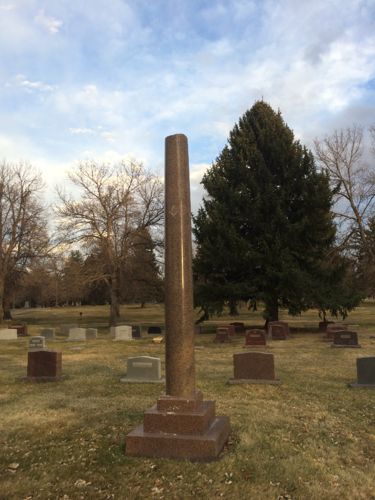
|
| Fairmount Cemetery Masonic column |
- The photo above shows what looks like a simple column. But if you look carefully at the top, it seems like the top of this column is broken off. The symbol of a Broken Column is common in Freemasonry. The column represents a Mason, and the Broken Column that of a life that has ended, or cut short.

|
| Fairmount Cemetery Masonic column detail |
- The photo above shows a closeup of the column. You can now clearly see the Masonic symbol of the Square and Compasses and the jagged edge of the broken top of the column.

|
| Fairmount Cemetery Masonic memorial |
- Across the road (to the north), happens to be another Masonic section of the cemetery, with a memorial in the center (photo above).

|
| Fairmount Cemetery Masonic memorial detail |
- The symbol of the Square and Compasses is sizeable and stands out in the sunlight, in the detailed photo above.
- There is at least one other Masonic section in the Fairmount Cemetery, but it is not clearly marked as such. Also, Masons may not necessarily choose to be in a specific Masonic section of a cemetery. Their graves may be interspersed throughout others. It's a personal choice. You may find that other cemeteries may be similar.
Example: Masonic Section of Chapel Hill Cemetery
- The Chapel Hill Cemetery in Littleton, Colorado has a unique Masonic section of the cemetery. In that cemetery are three large stone chair monuments placed far apart in a section of the cemetery. These three chairs are placed in the South, West, and East, re-creating the layout of a Masonic Lodge and are for the three principal officers of a Masonic Lodge: the Junior Warden, Senior Warden and Worshipful Master, and have the symbols of the officers carved into the chairs. In the center is a Masonic altar. There are many, many graves of Masons in the middle of this recreated "Lodge Room" in the cemetery.
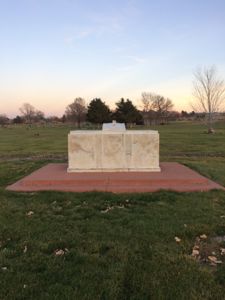
|
| Chapel Hill Cemetery - Masonic Altar |

|
| Altar Detail with Worshipful Master chair in the East |

|
| View of Junior Warden chair in the South |

|
| Junior Warden chair |

|
| Junior Warden chair symbol |

|
| View of Senior Warden chair in the West |
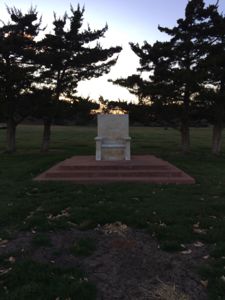
|
| Senior Warden chair |

|
| Worshipful Master chair in the East |
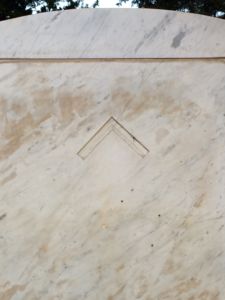
|
| Worshipful Master chair symbol |
Masonic Cemeteries
Occasionally there are whole cemeteries reserved for Freemasons and their families. One example is the Masonic Cemetery in Black Hawk, Colorado.

|
| Masonic Cemetery, Black Hawk, Colorado - Shed |
Obituaries
- Obituaries can be very useful sources of information on a person's involvement in Freemasonry. It can range from a simple, "... he was a Mason", to very elaborate recitations of all of the Masonic organizations that he was a member of or affiliated with, and any notable achievements. This information can be included in the Biography of a profile.
- The source of an obituary is typically a newspaper. The source should be written up in the form for a periodical. Many times a copy of it can be found online, so provide a link to the website. Many funeral homes are now providing a copy of an obituary on their website too. Finally, if you happen to possess a clipping of a newspaper, take a photo of it, upload it and attach it to the profile.
Membership Cards
- In the United States, and in more recent times, Lodges typically give out membership cards. Perhaps you might have those in your possession. This can be used to determine if the person was a Freemason, and also what Lodge they belonged to. Refer to the membership card in the Biography of a profile. If you have a membership card in your possession, it would be great to take a photo of it, upload it and attach it to the profile.
Family Bible, or Masonic Bible
- Another possible source is a Family Bible, or a Masonic Bible. In the United States, it is a regular custom among many Lodges to give a specially-made, personal "Masonic Bible" to newly made Master Masons (of the Christian Faith). Just like a Family Bible, there may be more information recorded in such a bible, particularly Lodge information, or dates for Initiation, Passing, and Raising (see Terminology above). If this is a source of information, then make a note of it in the Biography of a Profile.
Information from a Lodge or Grand Lodge
- Most of the time, Masonic Lodges have records of their members that typically go back to the very beginning of when a Lodge was formed. A lot of this information will also be recorded in the Grand Lodge records too. If this is a source of information, then make a note of it in the Biography of a Profile.
Proceedings of a Grand Lodge
Proceedings of annual Grand Lodge meetings (or communications) are published, and contain a wealth of information. Many contain a list of constituent (local) Lodges, and membership rolls. Many of these Grand Lodge proceedings can also be found online. The Hathi Trust Digital Library seems to have several available. Here are some links:
- Grand Lodge of Colorado
- Grand Lodge of Iowa
- Grand Lodge of Kentucky
- Grand Lodge of Massachusetts
- Grand Lodge of Montana
- Grand Lodge of New Jersey
- Grand Lodge of Ohio
Categorization
We are currently placing all known Freemasons in the Freemasonry category.
To add a profile into the Freemasonry category, add this text to the top of the profile: [[Category: Freemasonry]]
Please do NOT create other, similarly named categories. We are trying to use consistent terminology for category names, and profile text.
Subcategories
- There has been some discussion regarding creation of subcategories. Freemasonry is a topic where it is easy to go create a multitude of subcategories. The question is whether or not that makes sense, and whether it makes sense to do that right now, or at a later time. Here the current state of the discussion:
- Do not create a sub-category for a single Lodge. At the moment, there are not enough profiles in the Freemasonry category to warrant a highly-specific subdivision. It would end up placing a single person in a single category. This defeats the purpose of Categories and is not recommended usage of categories. If you wish to identify the Lodge that the person belonged to, then just include that information in the profile Biography.
- There is the possibility that we will create subcategories for the different Grand Lodges. This is seems like the next, most natural level in the hierarchy. The discussion has gone back and forth on the naming of the Grand Lodges, and whether or not to include the proper full name abbreviations at the end (e.g. "A. F. & A. M."). The difficulty is the Ampersand character is disallowed in category names, and technically it is a part of a full Grand Lodge name. We are now leaning towards simplicity in the category names and doing something like "Grand Lodge of Colorado", and then in the category, have the full details of the Grand Lodge name (including links). We think that this will help with adoption and usage. HOWEVER, at this point we don't even have enough Freemason profiles identified on the "Freemasonry" category to make it worthwhile to add subcategories for Grand Lodges yet. At some future point, these subcategories might be useful.
- Subcategories for different Appendant Bodies make the most sense. There is currently a subcategory for Order of the Eastern Star (OES), and this will remain. At some point we will very probably create subcategories for the Scottish Rite, Shriners (two of the most common appendant bodies), and perhaps York Rite, and others. The trade-off is that this could probably get to be extensive as historically there were quite a number of these bodies in the United States. In many cases, there is not enough information to place enough profiles in these categories, and the best place for this information is in the Biography of the profile itself.
Profile Stickers
You can add a profile sticker to a profile of a Freemason. Use the Society Member Template with the correct parameters to add a sticker. Remember to add it below the ==Biography== line in a profile.Some examples:
- Standard usage:
- {{Society Member|society=Freemason}}
- Expanded usage, with Lodge or Grand Lodge names:
- {{Society Member|society=Freemason|post=Enlightenment Lodge #198, Colorado}}
- For a living member:
- {{Society Member|society=Freemason|living=yes}}
You can also combine the "post" and "living" parameters in the template.
For members of the Order of the Eastern Star, just change the "society" parameter of the Society Member template, like so:
- {{Society Member|society=OES}}
Names of Lodges Used in a Profile
Lodges in the United States (and most often, elsewhere in the world) have a Name, a Number, and belong to a Grand Lodge. If a specific Lodge is being identified in a profile, then ideally it should have all three of those elements listed in that order.
- Example: Golden City Lodge #1, Grand Lodge of Colorado A. F. & A. M.
- We will be working on a consistent format for this identification for the future
- Despite what anyone tells you, or rumors that you may have heard, there is no Grand Lodge for the United States. It's a Grand Lodge per State.
Tracking Freemasons in Your Family
Adding Freemasons to the overall category helps. But what if you are interested in tracking Freemasons just in your family? The best way to do this is to use Personal Categories. Read more at the link on how to set this up. You can create your own Personal Category, and then a Personal Subcategory for Freemasons within your family. Place this subcategory on all the profiles that you want to track.
Tracking Lodge Information
If you wish to track information about a specific Lodge, the recommended method is to create a Free Space profile for any specific Lodge, and to place the information on that new Free Space profile page. Possibilities include a history of that Lodge, a list of Masters of the Lodge, notable people, links to the Lodge's website, etc.
Further Research
Most of the time, Masonic Lodges have records of their members that typically go back to the very beginning of when a Lodge was formed. A lot of this information will also be recorded in the Grand Lodge records too. You may be able to contact the Grand Lodge, or the specific Lodge, and let them know that you are doing genealogical research and would like to know if they can provide any assistance. For a Grand Lodge, contact the Grand Secretary. For an individual lodge, contact the Lodge Secretary.
To Do List
- Photos of gravestones showing symbols from other Masonic bodies. Scottish Rite, York Rite, Knights Templar, Shrine.
- Gather a list of all known published Grand Lodge proceedings. Probably put this on a separate Space page and link it from here.
- Make source profiles from the annual proceedings of the various Grand Lodges.
- Make a subcategory of Notable Freemasons. This should be the intersection of the Notable category and the Freemasonry category.
- Examples that need to be categorized:
- Go through list of Notable Freemasons on Wikipedia, and see if anyone has a profile on WikiTree, then add that profile to the category of Notable Freemasons.
- Announcing the Freemasonry Free Space Project Mar 1, 2016.
- Freemasonry in WikiTree Feb 28, 2016.
- Login to request to the join the Trusted List so that you can edit and add images.
- Private Messages: Send a private message to the Profile Manager. (Best when privacy is an issue.)
- Public Comments: Login to post. (Best for messages specifically directed to those editing this profile. Limit 20 per day.)
- Public Q&A: These will appear above and in the Genealogist-to-Genealogist (G2G) Forum. (Best for anything directed to the wider genealogy community.)

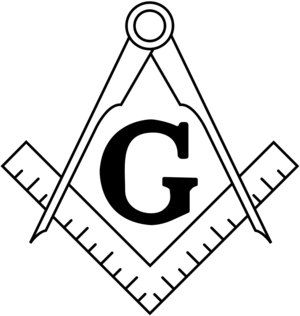

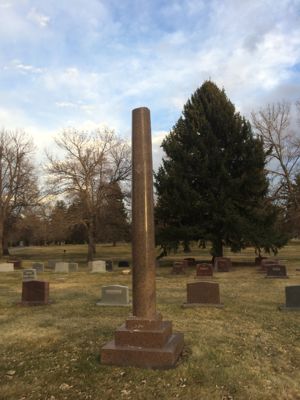


David Peter
Sorry to hear that it would cost you for the research at the Museum of Freemasonry, but in a way, that's not uncommon either. It's like paying for a professional genealogist to do research for you.
If you take a look at this page, at Categories > Subcategories (https://www.wikitree.com/wiki/Space:Freemasonry#Subcategories), it says to not create subcategories for individual lodges at this time. This is to comply with rules regarding categories in general. Categories are designed to have multiple people in them. As that section also states, just include that information about their lodge in the profile Biography.
Thank you for your reply. That seems a good idea not to make too many categories. (Ironically I have found a second member of Marine Lodge of Calcutta: Samuel Clark Kennedy (1837-1884).)
Thank you for looking after this 'space' on Wikitree.
Kind regards,
Robin
Although we do not recommend to create categories for individual Temples at this time, even though there are 3 at the moment. We're trying to get that fixed. Please just add the information about any Masonic associations in the Biography, as recommended.
I really appreciate you answering all my questions.
Thanks, Pat
My apologies for a late reply. I've been away and busy for the last few weeks.
Having a Masonic symbol on a gravestone or marker is a personal choice. It is not required. If the symbol is on the gravestone or marker, then you can be assured that the person was a Mason. If they do not have a symbol on the gravestone or marker, then you have to look for other evidence that they were a Mason. This is discussed extensively in the section "Identification & Sources" (https://www.wikitree.com/wiki/Space:Freemasonry#Identification_.26_Sources).
You are correct that all Shriners are Masons, but not all Masons are Shriners. I, myself, am a Freemason, but I am not a Shriner. There is a Shriner subcategory here: https://www.wikitree.com/wiki/Category:Shriners_International However, we discourage creating subcategories for the individual Temples. Please just add any Masonic affiliations in the Biography section of a person's profile.
I have a man who joined Globe Lodge 23 Grand Lodge(?) in England. I have put a standard usage sticker and on his profile. Is there a specific Lodge category I need to put him in? All I know is England & the Lodge number.
Thanks! Pat
See the Categorization section on this same page, here: https://www.wikitree.com/wiki/Space:Freemasonry#Categorization
Currently, we're trying to avoid creating subcategories, even though some have been created by others. Using the "Freemasonry" category is sufficient and you can use the sticker if you like. I would encourage that you document the Grand Lodge and Lodge that he was a member, if you know the information.
Is there only a category for OES & not a sticker?
Pat
.
I found quite few masons in my family so I will try help where I can. Not sure how good will be as had trouble with obit wording.
Billie
What should I do with a profile where the person was 1) a member of two different Lodges (one ancestor), and 2) a member of a Lodge, and, a member of a Chapter of the Royal Arch (another ancestor)?
I have a few ancestors who were members of different Grand Lodges, or Constitutions, and, in different countries, and, I have wondered whether their participation in Freemasonry, should be indicvated on their profiles, and, with the one who was also, a Steward in a Chapter of the Royal Arch, which is not referenced in the list of Freemasonry organisations for the particular country, on Wikitree.
I am wondering whether it would be simpler, if I could pass the information on to someone who is active in the Freemasonry project, who could properly label the profiles.
With one of my ancestors, I have been unable to find the particular Lodge (in Ontario, Canada), and, attempts to contact adjacent Lodges, have been unsuccessful. That he was a member of the Lodge, is apparently indicated in his obituary.
Please advise.
Thank you in anticipation.
edited by Bret Busby
We recommend to, at least, put the Freemasonry category on his profile. Then for all the details, just write them out in his Biography. There is no need at the moment to get to that level of details in categories. Mostly because the categories aren't set up and because there would be so few people in each category as to make them meaningless. The Category project recommends that no categories be created for such few people.
But we definitely recommend that, if you have the detailed information, please put that on his Biography. You can write it in as part of his Biography, or you can make a separate section if you like, that details his Masonic affiliations and any accomplishments. I would also be willing to review it if you like.
Thanks, Eric
edited by Eric Weddington
Please review the content relating to Freemasonry, on Busby-2030, Busby-2038, Busby-2031, and Busby-2045.
I have not been able to find from the NZ Freemasons, information about the membership of Busby-2044, who my father had told me 20 years ago (in an email message dated 20 September 2002), was also a Freemason, and so, I do not know that the email message from my father, is sufficient evidence, to label his uncle as having been a Freemason, especially, with my having been unable to find of what Lodge, my father's uncle Eric, was a member, or, any other details of his membership, other than my father having told me that his uncle Eric, was a member.
Thank you for your assistance.
https://www.wikitree.com/wiki/Myers-18583
Billie
https://grandlodgeofvirginia.org/contact/
Give the full name, birth date, and death date of William Barksdale Myers and ask what the Lodge name, Lodge number, and his initiation, passing, and raising dates and locations were for him. Also ask if there is any historical reference to him in the Grand Lodge archives. That should put you on track to fill in his Masonic background.
I will try to see if I can find out anything when I get time.
Billie
Thanks!
I not sure how to put Lodge Number and Other organizations in this person he belonged to so many lodges and Various mason Organization's could I get bit help. Most listed I think.
https://www.wikitree.com/wiki/Bright-1983
Billie
Billie
My father was a Mason, my mother was member of Eastern Star (for women) I was a member of Rainbow Girls (for daughters of masons) , my maternal grandfather was a mason, my paternal gr gr grandfather John Ralls, was a freemason in Ralls County, Missouri out of St Louis, Missouri. He then was in the war of 1846-48 and opened the first masonic lodge in Santa Fe New Mexico. Since he was a Grand Master
Mary Richardson
I sent you a PM on how to do this. Thanks for the comment!
Have added the Mason membership card to Guy Mayne's profile [ [ Main-1164 ] ] . I am going to contact my cousin Janet Cary Mary Ripley Cary' & William Cary's daughter to see what she has to prove membership for both of them in the organization. I know one of her cousins is doing a different side of the family's ancestry some where else and she is giving them info. I would imagine its Williams side of the family. Taylor
His WikiTree ID is Beckum-14. How should I add this information to his profile? How should I add him to the Freemason category? Thanks!
Yes, and I've fixed up the profile and replied privately.